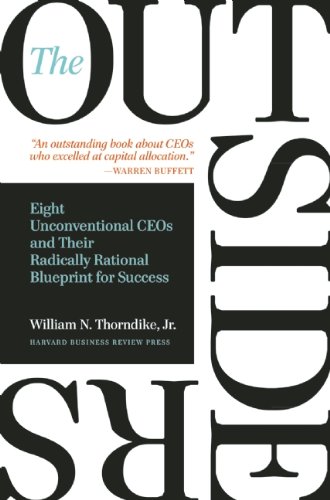

This article is an excerpt from the Shortform summary of "The Outsiders" by William N. Thorndike, Jr. Shortform has the world's best summaries of books you should be reading.
Like this article? Sign up for a free trial here .
What makes a Top CEO? Is it their business strategy, or is a Top CEO an inventor?
William Thorndike argues that the Top CEOs of all time are ones that went above and beyond what their competitors did, and successfully grew their businesses. These 8 Top CEOs followed smart, but unorthodox business strategies that made them the best in the business.
What Makes a Top CEO?
In general, Top CEOs have to do two things to succeed:
- Run operations efficiently to generate cash.
- Deploy the cash productively.
Most CEOs and most management books focus on the former. In contrast, Henry Singleton of Teledyne and the other outsider CEOs in the book focused on the latter. Rather than seeing themselves as company operators, the outsider Top CEOs saw themselves as investors and capital allocators first and foremost.
Despite the importance of capital allocation, little training is devoted to it. Business schools don’t feature capital allocation in curricula, and CEOs are promoted from functional roles (like product or marketing) without strong experience with investment in the business. Outsider CEOs saw it as their core job.
The 8 Top CEOs on this Top CEOs list each employed some version of the following strategies to make their companies successful:
- Decentralization
- Frugality
- Focus on Cash Flow
- Focus on Shareholder Returns
- Minimal Interaction with Investors
- No Particular Stroke of Luck
- Strong COOs as Partners
- Flexibility
- Personal Negotiations
- Focusing on the Important Factors
For this Top CEOs list, we’re focusing on one of each CEO’s core business strategies as an example. As you read think about how the strategies fit into the concepts outlined above, so you can get a sense of how they deployed the basic tactics of success in different ways.
#1: Tom Murphy, Capital Cities: Focus on Core Business
First on this Top CEO list is Tom Murphy of Capital Cities. When acquiring companies, Capital Cities focused on businesses it knew it could run well—media businesses that it could buy, make more efficient using its operating playbook, and thus turn into productive assets that could fuel further similar acquisitions. They knew the business model well—advertising-driven revenue with good margins and strong competitive barriers.
In contrast, its peer company CBS engaged in the conventional practice of acquiring unrelated businesses, such as toy businesses and the Yankees baseball team. The conventional thinking was that these acquisitions would lead to diversification, thus avoiding the variability of economic cycles, as well as synergies, where larger companies magically become more profitable through efficiency. However, like many acquisitions by conglomerates of this era, these did not materialize in meaningful synergies or better profits. Often, conglomerates acquired too rapidly and underestimated the difficulty of improving operations to realize cost efficiencies. Tom Murphy avoided this and become one of the Top CEOs.
#2: Henry Singleton, Teledyne: Decentralization
Henry Singleton ran one of the most successful business empires of the twentieth century, and he’s often featured on top companies CEO lists. In the era of conglomerates, the idea among many companies was that central headquarters could find large synergies among its subsidiaries. Thus, they employed armies of executives to conduct planning and strategy.
In contrast, Teledyne’s headquarters had fewer than 50 people, while its company employed over 40,000.
They even had a small board, featuring just 6 directors, including Singleton. Singleton ran a large conglomerate and quickly become of the Top CEOs.
#3: Bill Anders, General Dynamics: Flexible Strategy
Outsider CEOs tended to avoid concrete strategic plans, instead preferring flexibility to adjust to the circumstances.
When Anders, one of the Top CEOs, was actively selling businesses, he had actually intended to grow the fighter jet business through acquisition. He approached Lockheed’s CEO with the intent to buy their business, and was surprised when Lockheed instead countered with a generous offer to buy General Dynamics’s F-16 business. Had Anders been more stubborn about retaining the business, he might have missed this opportunity.
Likewise, a company needs different strategies in different situations. Anders grew the company’s value by aggressively shedding its non-core businesses and shrinking the company through improved operations. Just 6 years later, Chabraja grew the business lines through thoughtful acquisitions, including the massive bet on Gulfstream. Even more notably, he did so by selling stock, a rare move among outsider CEOs but appropriate at the time given that their stock was at an all-time high.
#4: John Malone, TCI: Intelligent Use of Debt
Like many acquisitive outsider CEOs, Malone used debt to finance acquisitions. As described earlier, he saw that growth for cable companies could come more cheaply than expected—depreciation of capital expenditures and interest expenses would reduce taxes, even if the company had healthy cash flow. Furthermore, increasing scale allowed TCI to access cheaper debt.
Through much of his tenure, he maintained a ratio of 5x debt to EBITDA. Malone also structured the debt intelligently to prevent defaults in one loan from cascading and causing systemic problems—in technical terms, he avoided cross-collateralization. (Shortform note: Enron’s downfall was caused in large part because of complicated dependencies between their loans. Read our summary of The Smartest Guys in the Room to learn more.
#5: Katharine Graham, The Washington Post: Financial Allocation
Graham is featured in many top companies and CEO lists, and is on this one because of her careful calculations as a Top CEO. As with the other outsider CEOs, Graham’s choices around how to get money and how to spend it caused the Post’s outperformance:
- The Post’s main source of capital was cash flow, generated when the Post lost its main competition in Washington and when her COO Simmons made business units more efficient. Unlike other CEOs mentioned thus far, Graham rarely sold Post businesses and did not regularly use debt.
- She rarely paid dividends, a rarity among newspaper companies, which were owned by families who depended on dividend income.
- She minimized capital expenditures, resisting upgrading print facilities. Like Malone at TCI, she preferred to let competitors rust into costly new technologies, waiting for them to prove economically profitable and allowing time to drive costs down.
- She avoided acquisitions when everyone else was acquiring, and she acquired companies when no one else was. Her trading rule: acquisitions had to return 11% over a 10-year period without leverage.
- She repurchased almost 40% of stock at opportune times, usually at single-digit P/E multiples.
#6: Bill Stiritz, Ralston Purina: Share Repurchases
Buying back shares was controversial in the 1980s, since it meant shrinking the company or admitting that there were no worthwhile investments to make. Instead, Top CEO Bill Stiritz used buybacks as a yardstick for return on investment—if an acquisition or internal investment could beat the return on buying back shares, it was worth doing. As with other outsider CEOs, most shares were purchased when company stock was at low P/E ratios.
#7: Dick Smith, General Cinema: Diversification
By the late 1960s, Bill Stiritz figured that theater growth would likely plateau at some point, so he began looking to diversify into other businesses. His ultimate goal was to have three legs in the company, each a strong business that wasn’t correlated with the others.
In 1968, he entered beverage bottling by purchasing American Beverage Company (ABC), the largest independent Pepsi bottler, for 20% of his company’s enterprise value. His work in theater concessions had given him an appreciation for the attractive market dynamics of beverage bottling:
- Beverage companies formed an oligopoly, representing high returns on capital and strong long-term prospects.
- Pepsi bottlers tended to be fragmented, compared to the larger Coca-Cola bottlers. Furthermore, since they served the #2 brand (Pepsi), they tended to have lower valuations. Thus, Smith could buy up bottlers for lower prices.
- ABC could serve as a platform company, to which new acquisitions of bottlers would be added to increase scale and profits.
Over the next decade, Smith purchased more bottling companies. Increasing scale allowed for ever more efficient operations, such as negotiating down can prices and buying its own sugar instead of having it supplied by Pepsi.
#8: Warren Buffett: Investment Strategy
Of course, Warren Buffett of Berkshire Hathaway is still one of the Top CEOs in the world, and is featured on numerous top companies and CEO lists. A big part of Berkshire’s investment strategy is its use of low-cost insurance float to invest in higher-return businesses. As a reminder, insurance float is money the company receives in premiums before they are paid out as claims. The time gap can be many years. In essence, this is like getting cash at 3% to reinvest at 13%.
Over the years, Berkshire continued scaling up the strategy in an accelerating flywheel effect. He could use insurance float to purchase companies that generated cash flow, which in turn he could use to buy more insurance companies, which generated more float to purchase companies. Insurance float grew from $237 million in 1970 to $70 billion in 2011.
As a large diversified company, Buffett also had more control over his insurance companies’ underwriting to maximize profitability. When premium pricing was low, Buffett’s insurance companies would underwrite fewer premiums; when pricing was high, it would take advantage by underwriting multiple-fold more in premiums. For instance, between 1984 to 1986, premiums grew sixfold, then shrank 73% by 1989. It’d be difficult for an independent public insurer to do the same, since its investors expect smooth performance. Buffett remains one of the Top CEOs in the world because of his large, diverse company and evolving investment style.
Each of these Top CEOs of this Top CEO list approached their business strategies for their companies with an eye on growth, and smart financial goals. With unorthodox thinking and intelligent use of resources, each of these Top CEOs achieved their goals in increasing their company’s value.

———End of Preview———
Like what you just read? Read the rest of the world's best summary of William N. Thorndike, Jr's "The Outsiders" at Shortform .
Here's what you'll find in our full The Outsiders summary :
- What great CEOs like Warren Buffett do that average CEOs don't
- How to master the art of capital allocation
- How to be a great manager that your team is excited to work with






